When I started building blogs for my business, I learned quickly that writing the content was only part of the job. Research, editing, and SEO took just as much time, and keeping a consistent schedule felt impossible while running a company. I knew I needed a way to save hours without lowering the quality of my work. That is when I began using AI tools for bloggers. They helped me streamline the process, fix mistakes faster, and stay visible in search results even without a large team.
I want to be clear with you. These tools do not replace your expertise, and they will not tell your story better than you can. What they do is give you more time to focus on the work that drives results. I have used them across different blogs and saw how they made publishing easier and more consistent. The growth became steady and reliable because I could focus on strategy and connection while the tools handled the routine work.
In this article, I will list down some AI tools for bloggers that I have tested myself, explain how they work, and share why they deserve a place in your content marketing toolkit.
Table of Contents
RightBlogger
RightBlogger is a toolkit that helps you produce blog content ideas and outlines quickly. I found it especially useful when my team needed to brainstorm multiple post angles during planning weeks. The platform gives prompts that match SEO-driven opportunities without feeling forced. You can adjust suggestions to match your niche rather than wasting time reworking generic ideas. It’s a time-saver for any blogger who wants momentum when starting drafts.
When I used RightBlogger, the best feature was its quick outline generation. Instead of staring at a blank screen, I had a clear structure to follow within minutes. It reduced the prep stage and allowed me to focus more on refining the writing. I still recommend editing and adding personal stories so the posts don’t sound automated. For idea generation though, this tool easily earns its place in my workflow.
CanIRank
CanIRank is built for bloggers who want practical SEO guidance rather than vague keyword scores. I used it to identify opportunities where my site could realistically compete. The recommendations were not just rankings, but actual action steps tied to my site’s strengths. This made the advice far more practical compared to broad SEO tools. If you’ve ever felt lost in endless keyword data, this tool brings clarity.
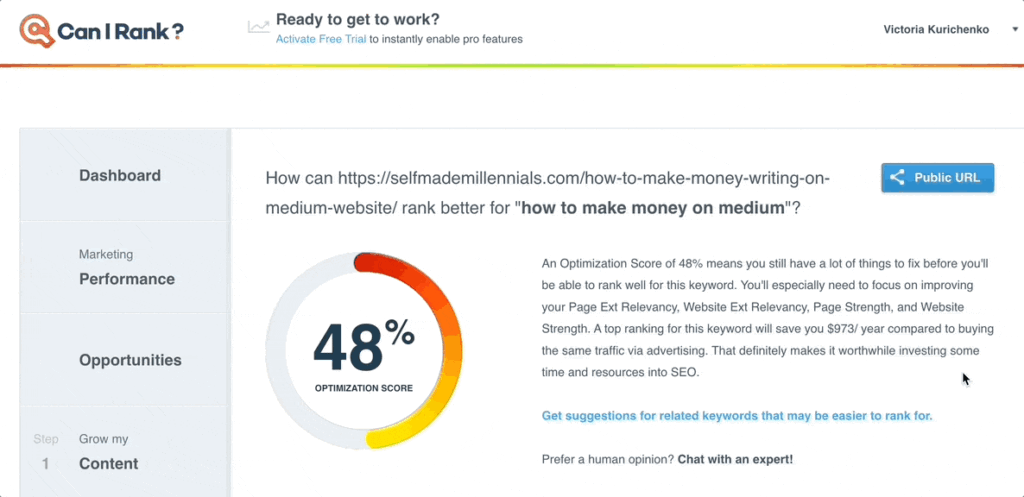
Another thing I valued about CanIRank is its competitive analysis. It showed me how my blog stacked up against others in the same space. I could see gaps where my content could win and areas where I needed backlinks. That perspective helped me allocate resources more wisely. It’s like having a consultant pointing out where your efforts actually pay off.
Surfer SEO
Surfer SEO helps bridge the gap between keyword planning and content execution. I used it to compare my drafts against top-ranking articles in real time. The interface highlights word counts, headers, and key terms without overwhelming you. For bloggers who want to balance creativity with ranking goals, this tool strikes a useful balance. It helped me sharpen content so it’s both optimized and natural.
What I like most is how it integrates with Google Docs. I didn’t have to switch between screens or copy-paste drafts into another platform. The live scoring gave instant feedback, so I could adjust while writing. It’s not a replacement for strong storytelling, but it makes sure your post aligns with search intent. If you want ranking results without sacrificing your style, Surfer SEO works.
Grammarly
Grammarly is one of those tools I’ve used for years and still keep open daily. It catches grammar slips, missing commas, and awkward sentence structures that busy writers often overlook. As a blogger managing deadlines, I can’t afford careless errors. Grammarly keeps my content polished before it goes live. Readers judge quality, and clean writing builds trust.
Beyond the basics, Grammarly offers tone suggestions that help match my brand voice. I’ve used it to refine posts where the language felt too stiff or too casual. That extra layer ensures consistency across my articles. It doesn’t replace an editor, but it saves them from fixing the same mistakes repeatedly. The tool raises the floor on quality before a human even touches the draft.
Humanize AI
Humanize AI focuses on making AI-generated text sound more natural. I tested it when I needed to repurpose AI drafts into something closer to my personal tone. The tool smooths robotic phrases and adds conversational rhythm. That’s important because audiences spot mechanical writing fast. If you’re using AI content, this tool helps close the gap between machine and human voice.
In practice, I’ve used Humanize AI to refine product reviews and longer guides. It reduced the amount of manual rewriting I usually have to do. Instead of starting over, I had a workable base that just needed my expertise layered on top. For time management, this has been a huge advantage. It lets me scale content without losing authenticity.
Alli AI
Alli AI is designed for on-page SEO automation. I used it across several blogs to streamline updates that usually take hours. The tool suggests code-level optimizations and applies them directly when connected to your site. For small teams without a developer, this function is powerful. It handles the technical side while you focus on content.
I liked how it simplified what used to feel complex. Tasks like title tag adjustments and internal linking became point-and-click jobs. This meant I could scale changes across dozens of articles without drowning in manual edits. It freed up time to create new content instead of constantly patching the old. Alli AI essentially gave me SEO at scale without the headache.
WordTune
WordTune helps you rework sentences for clarity and impact. I’ve used it when my drafts felt wordy or repetitive. The tool suggests alternative phrasings that maintain meaning but sharpen delivery. As someone who values clear communication with readers, this matters a lot. It’s like having a second set of eyes on every line.
In practice, I found WordTune especially useful for intros and CTAs. Those sections carry the most weight and benefit from tighter phrasing. The variations spark new ideas I might not have considered on my own. Instead of getting stuck on edits, I move forward faster. For bloggers who want crisp writing, this is a reliable helper.
Writesonic
Writesonic is one of the AI content platforms I tried for scaling blog drafts. It can generate full articles, social captions, and even ad copy. I tested it for first drafts of listicles and product comparisons. The speed was impressive compared to starting from scratch. Of course, refinement is still necessary to add depth and experience.
What stood out is its variety of templates. I could pick formats tailored to blog posts rather than forcing generic outputs into shape. That saved time during content planning because the structure was already aligned. The drafts were strong starting points that reduced my workload. Writesonic worked best as a productivity booster rather than a full replacement for human writing.
Koala AI
Koala AI positions itself as an AI writing tool with a focus on SEO. I used it to test how quickly it could produce optimized blog posts. The tool balances keyword placement with readable content, which is not easy to achieve. It gave me outlines and drafts that aligned with my target keywords. For niche blogging, this saves a lot of setup time.
Another benefit is its integration with real-time data. The posts it generated reflected current trends, which kept the content fresh. This made it especially useful for time-sensitive topics. Instead of researching and drafting for hours, I could have a polished framework much faster. With a few edits, the results were publication-ready.
ContentShake
ContentShake is built for small business owners who want guided blogging help. I used it to explore new ideas when I felt the editorial calendar was thin. The tool provides topic suggestions, outlines, and even draft support. It felt more like a co-writer than a pure automation tool. That balance made it easier to keep content aligned with my audience.
I found ContentShake especially helpful when I needed to publish consistently. It gave me practical prompts that reduced creative fatigue. Instead of forcing inspiration, I had a pipeline of fresh ideas. The content wasn’t perfect out of the box, but it provided structure. For busy owners juggling tasks, this tool helps keep momentum steady.
Copy AI
Copy AI is a platform I’ve used for a variety of marketing tasks. Beyond blogging, I’ve tapped it for email copy, product descriptions, and social posts. Its versatility makes it a good fit for owners running multi-channel content strategies. The speed of draft creation helps maintain consistency across platforms. It’s reliable for brainstorming and early-stage writing.
What I appreciate most is how easy it is to use. You don’t need training or tech knowledge to start producing content. I’ve had team members with no copywriting background jump in and produce workable drafts. This lowered the barrier to scaling content production. For small teams, that accessibility is a major win.
User Friendly AI Tools For Bloggers on Reddit
A Redditor recommends Claude and ChatGPT as the best options if you’re good at prompting and understand the chat style UI. They also state that using AI for blog generation is a net positive. They recommend others in the community to focus more time making the visual elements and editing of the content. The user does not recommend using AI to make an article and publishing it without any revisions.
Another community member says that they use Cuppa AI for mass creating blog posts. The tool works by uploading your keywords, choosing the article types and writing style. However, they state that you will need to sign up for an OpenAI API account to use Cuppa AI and some credits to your account as you use your own OpenAI keys.
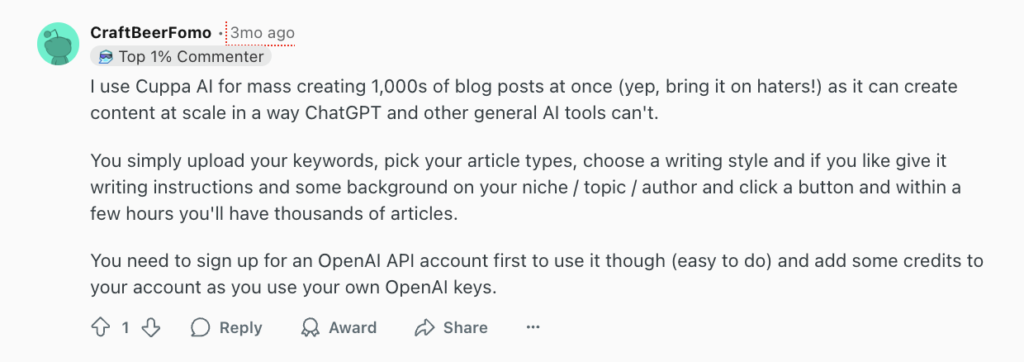
However, a Reddit member shares that creating generic content will only be useless. They suggest putting more work on research and finding low-hanging subheadings. They share that having an idea generation sheet is a gamechanger and helps them come up with fresh subheadings.

Someone shared that they publish AI-assisted articles under a different author name instead of their main profile. They let AI handle the research but still write the content themselves, and one of those pieces turned out to be one of their top-ranking articles. With so much of the internet already AI-generated, the smarter approach seems to be mixing real, organic writing with AI support so you can keep up with the big brands.
AI Tools For Bloggers on YouTube
Ben from blogwithb.com shared his top five AI tools for bloggers in 2024, and his picks actually feel practical. He uses ChatGPT less for writing and more for brainstorming content ideas and planning strategies, which makes sense. SEO Writing AI and Unbounce handle the heavy lifting of SEO-friendly articles and landing pages, while Alpha Rank keeps him sharp on trends and competitor moves.
I’ve been using AI to help with my blogging, and this video really hit home. AR points out that while you can’t rely on AI to test products or take photos, it can sharpen your writing and fill in gaps you might overlook. I often use it to rephrase clunky sections or create quick tables that make posts easier to skim. Like AR says, AI doesn’t cut corners but it adds polish that makes each blog more complete.
Is It Illegal To Use AI To Write A Blog?
No, it is not illegal to use AI to write a blog. I’ve been running content projects for years, and I can tell you that there are no laws preventing you from publishing AI-assisted writing. What matters is how you use it. If you pass AI work off as entirely your own without editing, you risk damaging your credibility, but there’s nothing unlawful about the practice. In fact, a 2023 McKinsey report found that over 50% of companies are already using AI in their marketing efforts.
The only issues that can come up are ethical or business-related, not legal. For example, some ad networks or publishers require content to meet originality standards, and AI text may need refining to pass those checks.
Search engines also reward quality and relevance, which means you should edit AI drafts to ensure they truly serve your readers. In my workflow, I use AI as a tool, not as the final author. As long as you add value and maintain transparency where needed, using AI to write a blog is completely legitimate.
How Do AI Tools For Bloggers Improve Content Quality?
AI tools for bloggers improve content quality by catching errors, suggesting stronger phrasing, and aligning posts with SEO requirements. According to a 2023 Grammarly Business report, 75 percent of professionals said AI writing assistance made their communication clearer and more effective.
In my own blogging, this means fewer awkward sentences slip through and articles feel more polished before publishing. When you combine this with platforms like Surfer SEO or CanIRank, you not only refine grammar but also match search intent more precisely. The result is content that reads smoothly while also ranking better. By using these tools consistently, you raise the baseline quality of every article you publish.
Which AI Tools For Bloggers Work Best For Seo Optimization?
The AI tools for bloggers that work best for SEO optimization are Surfer SEO, CanIRank, and Alli AI. A 2023 Backlinko study found that optimizing content with competitor-based analysis can improve rankings by up to 30%. Together, these platforms handle both content-level and site-level optimization, giving bloggers a complete advantage.
These AI tools for bloggers also help ensure that posts align with search intent and industry benchmarks. This increases the chances of appearing in top results while maintaining a natural reading experience for users. With consistent use, these tools turn SEO into a systematic process instead of guesswork.
How Much Do AI Tools For Bloggers Cost On Average?
From my experience, most AI tools for bloggers cost somewhere between $50 to $200 per month. At that price point, you can cover essentials like SEO optimization, grammar support, and draft generation without stretching your budget.
I’ve built content calendars around tools in this range, and they provided more than enough value to keep my publishing schedule on track. For an individual blogger or a small business, this level of investment is realistic and pays off quickly. You will notice the time savings almost immediately.
When you start running a larger team or producing content at scale, the costs go up. Advanced platforms with bulk publishing, in-depth analytics, or technical SEO automation can run into the higher hundreds each month.
I’ve worked with these plans, and while they are pricier, the efficiency they deliver more than makes up for it. The important thing is to match the tool to the stage your blog is in. Start with the basics, then step up when the extra features will actually move the needle for your business.
Are AI Tools For Bloggers Effective For Small Business Owners?
I can say that AI tools for bloggers are very effective for small business owners. They save hours on tasks like keyword research, editing, and draft generation, which gives you more time to focus on running the business.
A 2023 HubSpot survey found that 43%t of marketers already use AI for content creation, and many report faster turnaround times with better consistency. I’ve seen this firsthand when managing multiple blogs on top of client work. Without these tools, I would have needed to hire more staff just to keep up.
The real strength of AI tools for bloggers is that they lower the barrier to entry. Even if you don’t have a big budget or a full marketing team, you can still produce content that looks professional and ranks well in search. For small businesses, that kind of leverage is a game changer.
You can publish at a steady pace, compete with larger brands, and keep your message consistent without burning out. In my experience, the return on investment shows up quickly once you make them part of your workflow.
What Are The Limitations Of Using AI Tools For Bloggers?
AI tools for bloggers are powerful, but they do come with limits you need to be aware of:
- Lack of originality: AI tools often pull from existing patterns, so the content can feel generic if you don’t add your own insights.
- Limited context: These tools can miss the nuance of your brand voice or the specific angle your audience expects.
- Over-reliance risk: If you lean too heavily on AI, your content may lose the personal touch that builds trust with readers.
- Ongoing cost: Subscriptions add up, and if you’re not consistently publishing, you may end up paying for tools you barely use.
Can You Monetize An AI Blog?
Yes, you can monetize a blog that uses AI tools for content creation, and I’ve done it in my own business. The key is to treat AI as a starting point and then refine the drafts with your own expertise so they stand out. Once the articles deliver genuine value, you can use them to grow traffic and build an audience that converts.
According to Influencer Marketing Hub, beginner bloggers typically earn around $200 to $2,500 per month, while established blogs that scale traffic and monetize effectively can bring in $10,000 or more each month. Those numbers are realistic if you commit to consistent publishing and smart monetization strategies.
AI tools simply make it easier to publish consistently, which is the real driver behind revenue growth. The more useful content you have, the more search traffic and engagement you attract. With the right strategy, an AI-assisted blog can grow into a solid income stream.
Conclusion: Are AI Tools For Bloggers Reliable For Long-Term Growth?
AI tools for bloggers are reliable for long-term growth as long as you use them the right way. They save time, cut costs, and help you publish more consistently, which are all critical for building authority. What makes the difference is how you combine these tools with your own knowledge and brand voice.
AI alone won’t carry your blog forward, but when paired with strategy and creativity, it creates a strong foundation for scaling. I’ve seen this approach work across multiple sites, and the results hold up over time.
The truth is that blogging success has always depended on consistency and value, and AI tools simply make those two factors easier to maintain. They handle the repetitive tasks while you focus on direction, storytelling, and connecting with your audience.
If you stay committed to refining your content and tracking performance, the growth compounds year after year. For me, these tools have become part of a system that supports reliable, sustainable progress. Used wisely, they can do the same for you. Check out our other reviews that will help you grow your knowledge in building a thriving business online.

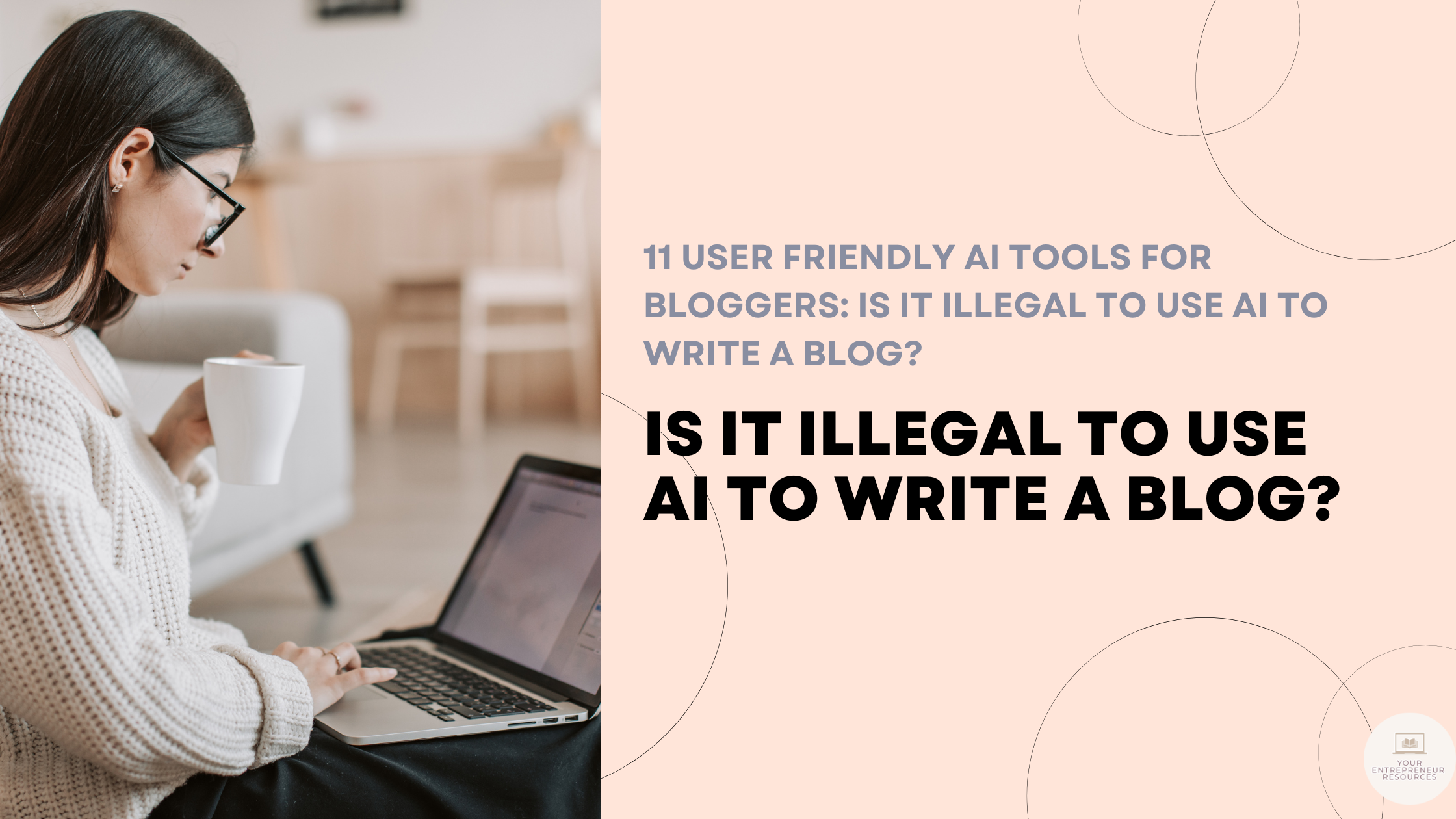
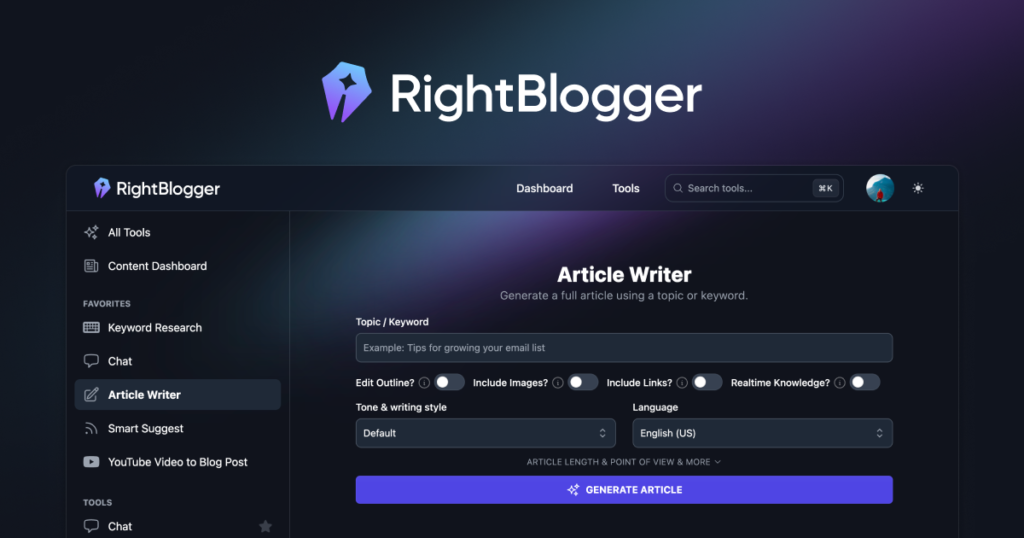
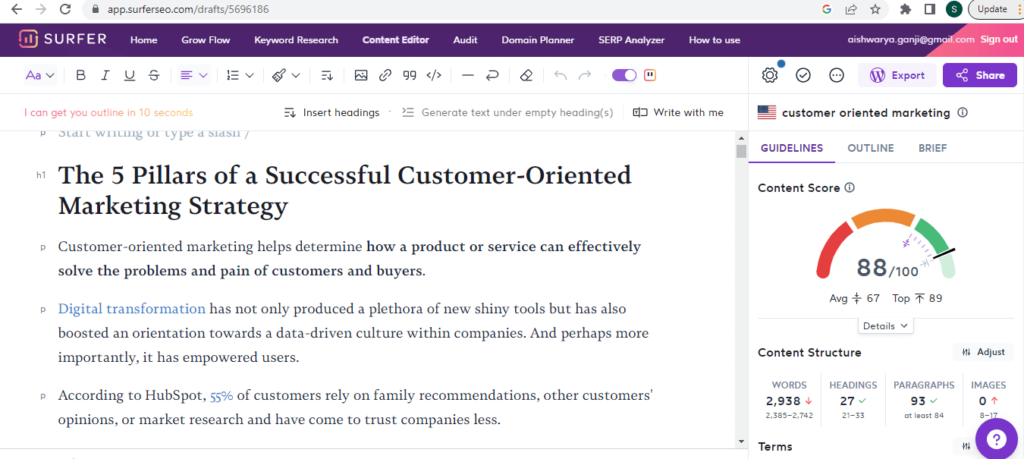
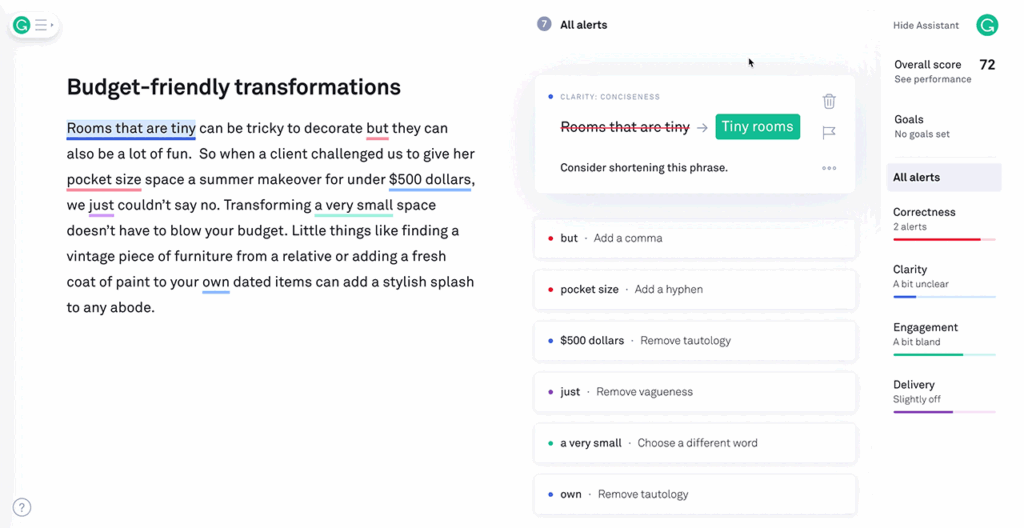




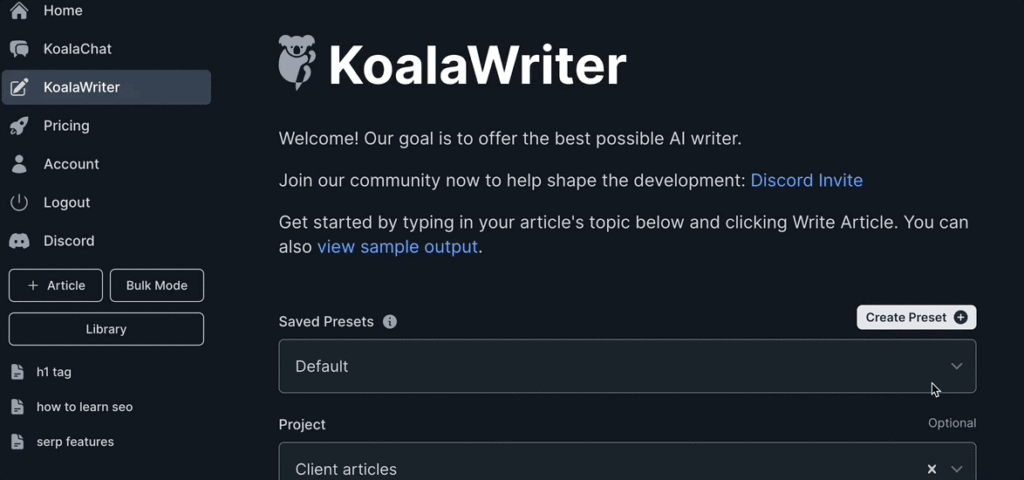

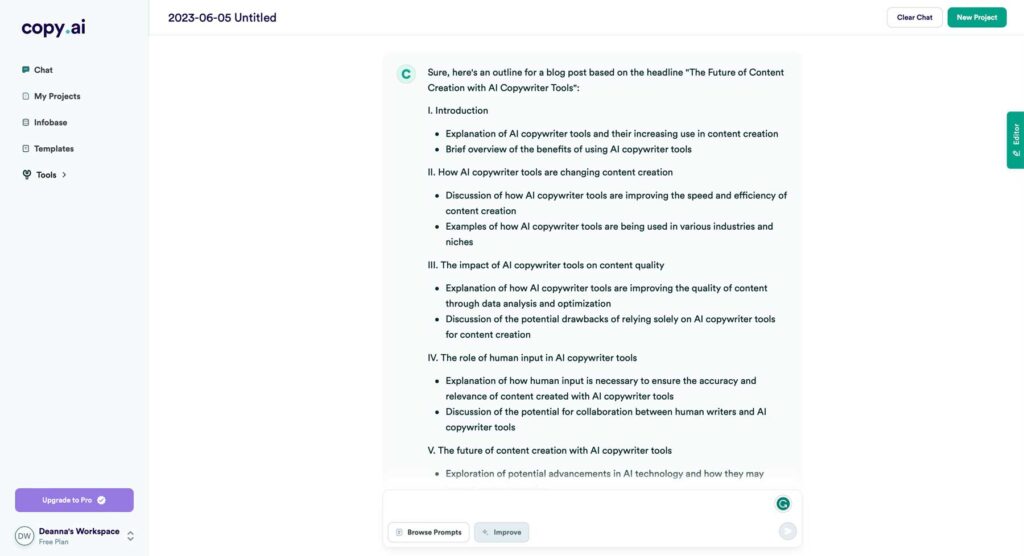

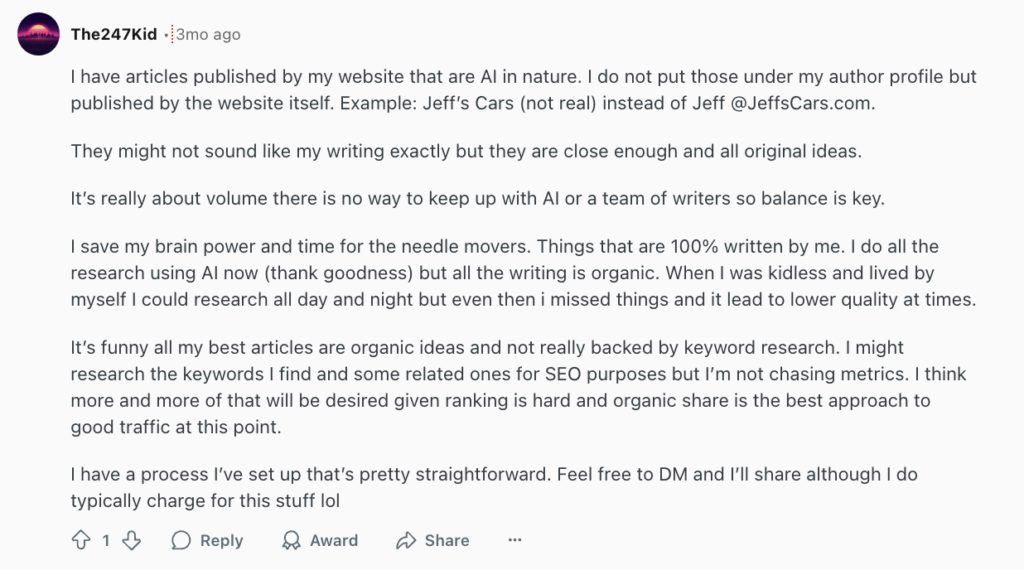






0 Comments